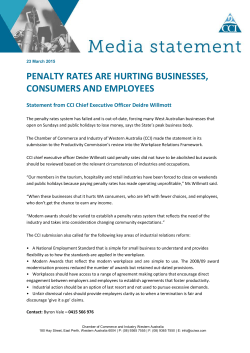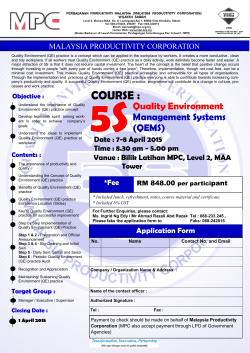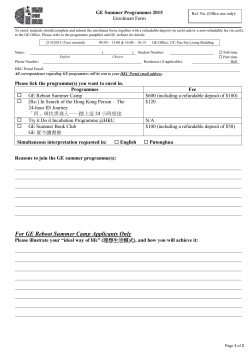
Awards Criteria - Global Centre for Healthy Workplaces
Global Healthy Workplace Awards 2015 Awards Criteria Two finalists in each category will be notified by mid-March and will be required to present their health programme at the Global Healthy Workplace Awards Summit in Florianopolis, Brazil, on 18-19 May 2015. For further information please visit: www.globalhealthyworkplace.org CONTENT Global Awards Categories & Basic Requirements……………....2 Evaluation Criteria & Self-Assessment Checklist………………...3 www.globalhealthyworkplace.org | info@globalhealthyworkplace.org 1 Global Awards Categories Open to all employer organisations (for profit and not-for-profit): 1. Small and Medium-sized Enterprises (SMEs): with less than 500 employees who run exemplary programmes. 2. Large Enterprises: with over 500 employees who run exemplary programmes at one local worksite. 3. Multi-national enterprises: employers with employees in different countries who run exemplary programmes across multiple worksite locations and countries. Basic requirements: • • • • • • • • All applying organizations adhere to workers’ social and ethical codes as part of their role in the broader community and enforce occupational health codes and laws Applicants can be private, public or non-profit organizations Programmes are based in the workplace Applicants follow the word and graph limit specified below Applicants must be willing to provide information on the Global Awards website and other outlets selected by the host organisations Applicants must be willing to participate in ongoing profiling for a minimum of twelve months, e.g. at regional seminars, periodical newsletters and on the website. Applicants will not use supporting materials with their application. Finalists will attend the 2015 Global Awards Summit to present their program where they can gain another 20 points (maximum). No videos will be allowed for this presentation. www.globalhealthyworkplace.org | info@globalhealthyworkplace.org 2 Evaluation Criteria and Self-Assessment Checklist Leadership commitment & engagement ❑ Major stakeholders (e.g. senior leadership, union leadership) are mobilized and committed to integrate healthy workplaces into the enterprise’s business goals and values. ❑ Necessary permissions, resources and support have been obtained. ❑ Key evidence of this commitment is provided by developing and adopting a comprehensive policy that is signed by the enterprise’s highest authority, which clearly indicates that healthy workplace initiatives are part of the organization’s business strategy. Worker involvement ❑ Workers and their representatives are actively involved in every step of the process from planning to evaluation considering their opinions and ideas. ❑ Workers have collective means of expression, stronger than that of individual workers, e.g. through trade unions or representation by regional worker representatives. ❑ The programme enjoys broad participation among the workers. Business ethics and legality ❑ The enterprise abides by one of the most basic of universally accepted ethical principles: to “do no harm” to others and to ensure employees' health and safety. ❑ Adheres to workers’ social and ethical codes as part of their role in the broader community. ❑ Enforces occupational health codes and laws. ❑ Takes responsibility for workers, their families and the public and avoids undue risks and human suffering. Sustainability and integration ❑ Senior management is committed to use a health, safety and wellbeing “filter” for all decisions. ❑ The healthy workplace initiatives are integrated into the enterprise’s overall strategic business plan. ❑ Cross-functional teams or matrices are used to reduce isolation of work groups and a health and safety committee and a workplace wellness committee has been established. ❑ Programmes are evaluated and continuously improved. www.globalhealthyworkplace.org | info@globalhealthyworkplace.org 3 ❑ Measurement in various areas is conducted: health, employee engagement and participation, financial performance, customer satisfaction, internal business processes and employees’ learning and growth to develop long-term business success. ❑ A comprehensive view to workplace health and safety is maintained and all aspects to identify a wider range of effective solutions are examined. ❑ External influences such as lack of primary health care resources in the community are considered. ❑ The programme has a plan for continued operation and ongoing improvements. Follow Continuous Improvement Cycle: Strategic commitment to a healthy workplace has been mobilized. The required resources have been assembled. The current situation and the desired future have been assessed. Priorities have been developed. A comprehensive overall plan and specific project action plans have been developed by learning from others, for example, consulting experts from a local university or asking experienced union leaders to act as mentors, visit other enterprises, consulting the virtual world. ❑ The plan has been implemented. ❑ The acceptance and effectiveness of the plan has been evaluated. ❑ When circumstances indicate that it is needed programmes have been improved. ❑ ❑ ❑ ❑ ❑ Innovative ❑ The programme contributes to learning and building an evidence base. ❑ The programme introduces applications that have demonstrated. success in other areas into new settings and/or implements a novel approach. Replicable ❑ The programme shows promise for implementation by other organisations. ❑ The programme shows promise for implementation on a larger scale. ❑ The programme shows promise for implementation in diverse environments (e.g., urban and rural, large and small enterprises, different industries and countries). www.globalhealthyworkplace.org | info@globalhealthyworkplace.org 4 Please proceed to the questions on the Application Form document. Your application will be evaluated based on your responses to the questions on the Application Form and not the checklist above. www.globalhealthyworkplace.org | info@globalhealthyworkplace.org 5
© Copyright 2025









